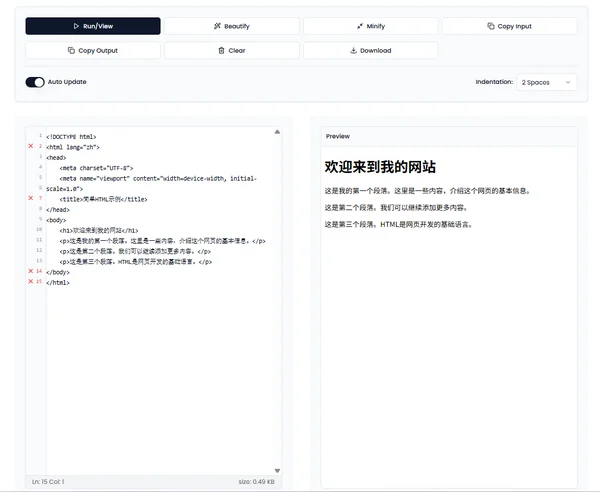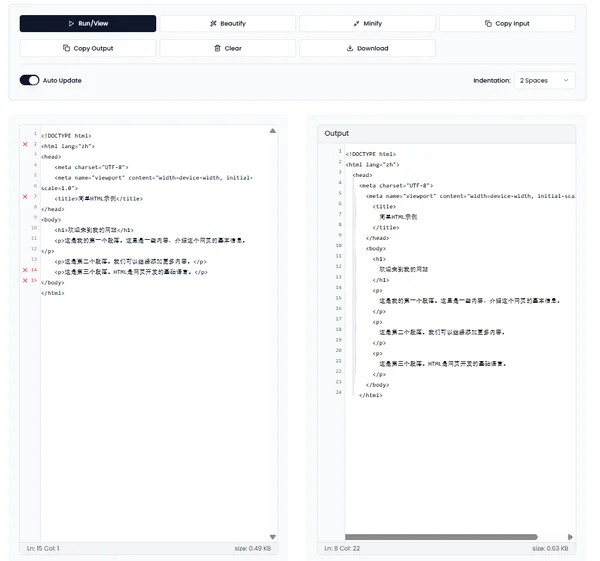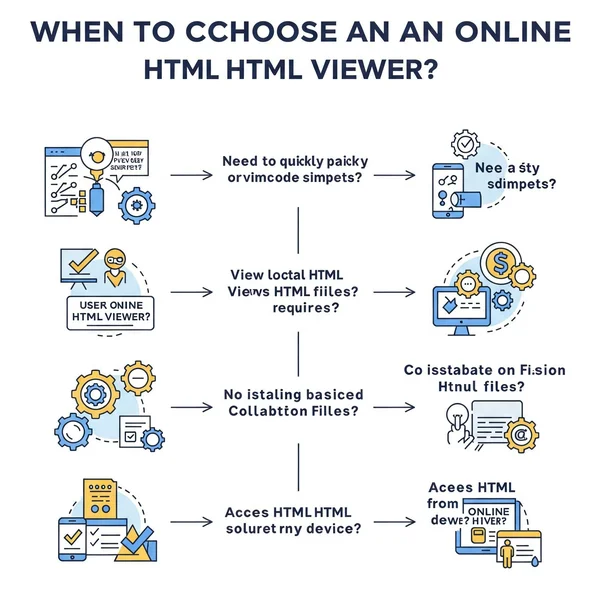HTML Viewer vs DevTools: Which for Your HTML Task?
How to choose an online HTML viewer and browser development tools
In the world of web development, having the right tools at your disposal can make all the difference in efficiency and productivity. When it comes to working with HTML, two common categories of tools often come into play: dedicated online HTML viewers and the powerful Browser Developer Tools (DevTools) built into browsers like Chrome. But html viewer vs chrome devtools? Which one should you reach for, and when? Understanding their core strengths and ideal use cases will help you view html code and debug issues more effectively. This guide will compare these tools, with a nod to how an online html viewer can be a valuable asset in your toolkit.
Understanding Online HTML Viewers
When to use online html viewer? These web-based tools are designed for specific, often quick, HTML-related tasks.
Core Focus: Quick HTML Preview & Code Inspection
The primary strength of an online HTML viewer, such as the one available on our site, lies in its ability to provide a quick html preview and straightforward code inspection. You can paste HTML code, upload a local file, or sometimes even point to a URL, and instantly see how the HTML renders and review its source. It’s about getting a fast, no-fuss look at HTML content.

Key Strengths: Simplicity, Speed, and Accessibility
Simplicity is a hallmark of these tools. They typically have a clean interface focused on just a few core functions. This leads to speed – you can get your HTML rendered or its source displayed in seconds without navigating complex menus. Furthermore, their web-based nature ensures accessibility from any device with a browser, without needing any installation. An html viewer online is always just a URL away.
Common Use Cases: Snippet Testing, File Viewing, Learning
So, what are these tools best for?
- Snippet Testing: Quickly paste a small piece of HTML to see how it looks or if it's syntactically correct.
- File Viewing: Easily open and view local
.htmlfiles, especially useful for assignments or downloaded templates, which our HTML file viewer handles adeptly. - Learning HTML: Beginners find the immediate visual feedback incredibly helpful for understanding how HTML tags translate into web content.
Exploring Browser Developer Tools
Browser Developer Tools, often referred to as DevTools (with Chrome DevTools being a prominent example), are a comprehensive suite of utilities built directly into most modern web browsers.
Core Focus: In-Depth Debugging & Live DOM Manipulation
DevTools are powerhouses designed for in-depth debugging of web pages. They allow developers to inspect html elements in their live context, perform live DOM manipulation (changing the structure, content, or style of a page on the fly), debug JavaScript, analyze network activity, and much more.

Key Strengths: Comprehensive Analysis, Network Monitoring, Performance Profiling
The strengths of DevTools lie in their comprehensive analysis capabilities. You can dive deep into the CSS cascade, understand JavaScript execution, perform network monitoring to see how resources are loaded, and even conduct performance profiling to identify bottlenecks. They are indispensable for professional web development.
Common Use Cases: Complex JavaScript Debugging, CSS Refinement, Performance Optimization
DevTools shine when you need to:
- Perform
complex JavaScript debuggingwith breakpoints and call stacks. - Achieve intricate
CSS refinementby inspecting styles and experimenting with changes in real-time. - Conduct
performance optimizationby analyzing load times and script execution.
Task-specific online HTML viewers are compared with developer tools
Let's compare how these tools fare in common scenarios. What are limitations of online html viewers compared to DevTools in certain tasks?
Task: Quickly Previewing a Local HTML File or Snippet
For a fast, isolated preview of an HTML snippet or a local file, an online HTML viewer often wins. It’s quicker to paste or upload than to open a new browser tab, save a temporary file, and then open it. Our HTML preview tool excels here.

Task: Viewing HTML Source of a Live Webpage
Both can do this. DevTools (right-click > "View Page Source" or using the Elements panel) gives you the source in the context of the live page. An online HTML viewer that accepts URLs will fetch and display the raw HTML, which can be simpler if you only want the HTML without other browser interface elements.
Task: Debugging Complex HTML & CSS Layout Issues
While an online HTML viewer with real-time preview can help spot initial layout problems quickly, Chrome DevTools (and similar) offer far more power for diagnosing complex CSS interactions, understanding the box model in detail, and visualizing layout boundaries.
Task: Inspecting and Modifying the Live DOM
This is squarely DevTools territory. The ability to select an element on the page and see its corresponding HTML and CSS, then modify them live, is a core strength of browser developer tools. An online HTML viewer typically doesn't interact with a live, external webpage's DOM in this way.
Task: Learning HTML and CSS Fundamentals
For absolute beginners, the simplicity of an online HTML viewer can be less intimidating. The immediate, focused feedback loop (code in, preview out) is excellent for learning HTML and basic CSS. This HTML viewing platform provides an excellent starting point.
When to Choose Which: Making the Right Decision
So, what's the best tool to view html? It depends on the job.
Choose an Online HTML Viewer (like Ours) When...
- You need a quick preview of an HTML snippet or local file.
- You want a simple, no-install tool for basic
code inspection. - You're learning HTML/CSS and want immediate, straightforward visual feedback.
- You need to share an HTML rendering easily (by sharing a link to a viewer with pasted code, if supported).
- This HTML viewer service is perfect for these scenarios.

Opt for Browser DevTools When...
- You need to perform in-depth debugging of a live website.
- You need to inspect and modify the live DOM and CSS dynamically.
- You're debugging JavaScript or analyzing network requests.
- You require comprehensive performance analysis.
- You're working within the full context of a loaded webpage.
HTML Viewer or DevTools? The Best Tool is the Right Tool
Ultimately, online HTML viewers and Browser DevTools are not mutually exclusive; they are complementary tools in a developer's arsenal. Understanding their distinct strengths allows you to choose the most efficient one for the task at hand, whether it's a quick html code inspection or a deep dive into JavaScript debugging.
For those moments requiring a fast, accessible, and simple way to view and preview HTML, remember that an online HTML viewing solution is an excellent choice. Which tool do you find yourself reaching for more often, and why? Share your preferences in the comments below!
HTML Viewers, DevTools, and Choosing Between Them
Here are some common questions about these tools:
-
Can an online HTML viewer replace Chrome DevTools entirely? No, they serve different primary purposes. An
online HTML vieweris excellent for quick previews and simple inspection, whileChrome DevToolsoffer a comprehensive suite for in-depth debugging and live page analysis. They complement each other rather than replace. -
Is an online HTML viewer good for beginners learning HTML? Absolutely. The simplicity, immediate feedback, and lack of setup make an
online HTML viewerlike this platform an excellent tool for beginners to see how their code translates into visual output, aiding thelearning HTMLprocess. -
How do I open HTML viewer in Chrome? When people refer to "HTML viewer in Chrome," they usually mean Chrome's built-in
Developer Tools. You can access these by right-clicking on a webpage and selecting "Inspect," or by pressing F12 (or Fn+F12). For anonline HTML viewerlike ours, you simply navigate to its website address in Chrome or any other browser. -
What are the main limitations of online HTML viewers compared to DevTools? The main
limitations of online html viewersinclude a lack of in-depth JavaScript debugging capabilities, no network analysis tools, no direct live DOM manipulation of external sites, and generally fewer advanced features for performance profiling or comprehensive CSS analysis compared to the robustbrowser developer tools.